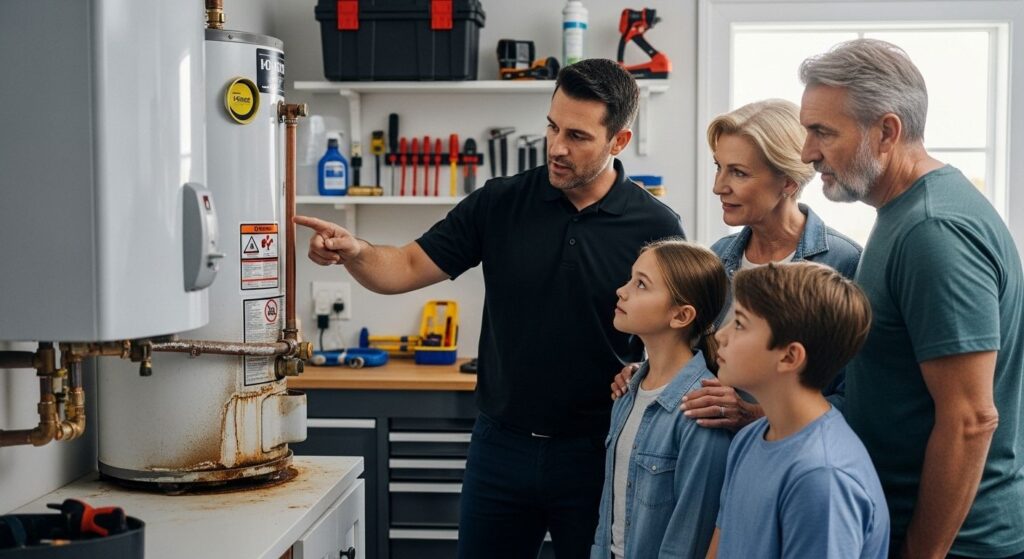Water heater problems can bring daily life to a standstill and nobody wants to deal with cold showers or mysterious leaks. Strange thing is, over 75 percent of water heater failures happen because of issues you can actually prevent with routine maintenance and quick repairs. Most people think their tank will just keep working until it bursts but the real surprise is how a bit of know-how and timing can help your water heater last up to 15 years while keeping those dreaded emergencies out of your home.
Table of Contents
- Insufficient Hot Water: Causes And Solutions
- Strange Noises: Troubleshooting Your Water Heater
- Leaks And Drips: How To Identify And Repair
- Rusty Or Discolored Water: What You Need To Know
- Thermostat Issues: Adjustments And Fixes
- Water Heater Odors: Identifying The Source
- Routine Maintenance: Tips For Longevity
Quick Summary
| Takeaway | Explanation |
|---|---|
| Check thermostat settings | Ensure thermostat is set between 49-60 degrees Celsius for optimal hot water temperature. |
| Flush the tank regularly | Perform tank flushing every three to four months to remove sediment buildup, improving efficiency and performance. |
| Look for signs of leaks | Visible water pooling indicates a leak, requiring immediate attention to prevent water damage and system failure. |
| Inspect for discoloured water | Rusty or discoloured water signals potential internal corrosion or pipe deterioration, necessitating professional diagnosis. |
| Schedule routine maintenance | Annual inspections and maintenance extend water heater lifespan and help avoid costly repairs by addressing potential issues early. |
1: Insufficient Hot Water: Causes and Solutions
Running out of hot water too quickly can disrupt your daily routine and signal underlying issues with your water heater. According to Natural Resources Canada, understanding the potential causes of insufficient hot water is crucial for maintaining your home’s comfort and efficiency.
Multiple factors can contribute to inadequate hot water supply. The most common reasons include:
-
Thermostat settings: An incorrectly calibrated thermostat might prevent your water heater from reaching the desired temperature
-
Sediment buildup: Mineral deposits can accumulate in the tank, reducing heating efficiency and available hot water volume
-
Faulty heating elements: Electric water heaters rely on functional heating elements to warm water effectively
Diagnosing the Problem
Start by checking your water heater’s thermostat. Ensure it is set between 49-60 degrees Celsius for optimal performance. If the setting seems correct, inspect the heating elements or consider professional assessment.
For older water heaters, sediment accumulation can significantly impact performance. Regular maintenance, including annual tank flushing, helps prevent efficiency loss. Learn more about water heater maintenance.
If your water heater consistently fails to provide sufficient hot water, it might indicate a more serious underlying problem. Professional plumbers can conduct comprehensive diagnostic tests to identify and resolve specific issues, ensuring your home maintains a reliable hot water supply.
2: Strange Noises: Troubleshooting Your Water Heater
Strange sounds emerging from your water heater are more than just an annoying distraction. According to the University of Hawai’i Building Maintenance Guide, unusual noises often indicate underlying mechanical problems that require immediate attention.
The most common water heater sounds include:
-
Popping or crackling: Typically signals sediment buildup in the tank
-
Rumbling: Suggests substantial mineral deposits have accumulated
-
High pitched squealing: Could indicate issues with valves or potential pressure problems
Understanding Noise Origins
Sediment accumulation represents the most frequent cause of disruptive water heater sounds. As minerals like calcium and magnesium settle at the tank’s bottom, they create a barrier between the water and heating element. This reduces heating efficiency and generates distinctive popping noises during water heating cycles.
Practical Solutions
Addressing these sounds requires systematic intervention. Flushing the tank remains the primary recommended solution. This process involves draining the water heater completely, removing sediment, and restoring optimal performance. Explore our comprehensive water heater troubleshooting techniques for detailed maintenance guidance.
Persistent or escalating sounds might signal more serious mechanical failures. Professional plumbers can conduct thorough diagnostics, identifying whether the issue requires minor repairs or potentially signals the need for water heater replacement. Prompt attention prevents potential system breakdowns and ensures consistent hot water supply for your home.
3: Leaks and Drips: How to Identify and Repair
Water heater leaks represent a serious issue that can quickly escalate from a minor inconvenience to a potential home disaster. According to the Canadian Forces Housing Agency, identifying and addressing leaks promptly is crucial for maintaining equipment integrity and preventing extensive water damage.
Key areas prone to water heater leaks include:
-
Tank bottom: Often indicates significant corrosion or sediment buildup
-
Connection points: Loose fittings or degraded seals around pipes and valves
-
Pressure relief valve: Can develop leaks due to excessive internal pressure
Warning Signs
Visible water pooling around the base of your water heater is the most obvious indicator of a potential leak. Other subtle signs include rust-colored water, musty odors near the tank, or unexplained increases in water bills. These symptoms suggest immediate professional assessment is necessary.
Immediate steps to manage a water heater leak:
-
Turn off the power supply to the water heater
-
Shut off the water inlet valve
-
Place a bucket underneath the leak to catch dripping water
Learn more about our comprehensive leak detection and repair techniques to understand the nuanced approaches professionals use to diagnose and resolve water heater issues.
While some minor leaks might seem manageable as a DIY project, most water heater leak repairs require specialized knowledge. Attempting unauthorized repairs can void warranties and potentially cause more significant damage. Professional plumbers can accurately diagnose the leak’s origin, recommend appropriate solutions, and ensure your water heating system remains safe and functional.
4: Rusty or Discolored Water: What You Need to Know
Rusty or discolored water emerging from your hot water tap signals potential problems within your water heating system. According to the United States Geological Survey, water discoloration often results from the presence of minerals like iron and manganese.
Primary causes of water discoloration include:
-
Corroded tank interior: Aging water heaters develop rust and sediment buildup
-
Degrading anode rod: The sacrificial metal rod designed to prevent tank corrosion
-
Pipe deterioration: Older metal pipes can introduce rust particles into water supply
Understanding the Risks
Discolored water is more than an aesthetic issue. Rust particles can indicate potential structural damage to your water heater and may signal imminent system failure. The presence of rust can also suggest compromised water quality and potential health risks.
Important steps to address discolored water:
-
Flush the water heater tank completely
-
Inspect the anode rod for significant corrosion
-
Check water supply pipes for potential deterioration
Learn about preventing water heater corrosion through regular maintenance to extend your system’s lifespan and maintain water quality.
While some minor discoloration might be temporary, persistent rust-colored water requires professional assessment. Plumbing experts can perform comprehensive diagnostics to determine whether your water heater needs repair or complete replacement, ensuring safe and clean water delivery to your home.
5: Thermostat Issues: Adjustments and Fixes
Thermostat problems can significantly disrupt your water heater’s performance and efficiency. According to research from the University of Hawai’i Maui College, identifying and addressing thermostat issues promptly is crucial for maintaining consistent hot water supply.
Common thermostat-related symptoms include:
-
Inconsistent water temperature: Water that is too hot or too cold
-
No hot water: Complete failure of heating mechanism
-
Frequent temperature fluctuations: Unpredictable water heating cycles
Understanding Thermostat Functionality
Water heater thermostats regulate the temperature by monitoring and controlling heating elements. A malfunctioning thermostat can lead to energy inefficiency, increased utility costs, and potential safety risks. Modern water heaters typically feature two thermostats in electric models: one for the upper heating element and another for the lower element.
Basic diagnostic steps for thermostat issues:
-
Check electrical connections for any loose wiring
-
Test thermostat continuity using a multimeter
-
Verify the temperature setting is appropriate
Explore our comprehensive guide to water heater maintenance and troubleshooting to understand more about managing your system effectively.
While some homeowners might attempt DIY repairs, thermostat issues often require professional expertise. Incorrect adjustments can lead to further damage or create potential electrical hazards. Professional plumbers can accurately diagnose the root cause, perform precise calibrations, and ensure your water heater operates safely and efficiently.
6: Water Heater Odors: Identifying the Source
Unusual odors emanating from your water heater can indicate serious underlying problems. According to Health Canada, certain water heater odors may signal potential health and safety concerns that require immediate attention.
Common water heater odors and their potential causes include:
-
Rotten egg smell: Often indicates bacterial growth in the water tank
-
Musty or earthy odor: Potential mould development inside the tank
-
Metallic scent: Suggests potential corrosion of internal tank components
Understanding Odor Origins
Bacterial contamination represents one of the most frequent sources of water heater odors. These microorganisms thrive in warm, stagnant water environments, producing hydrogen sulfide gas that creates the distinctive rotten egg smell. The bacteria typically enter through groundwater or develop when the water heater sits unused for extended periods.
Immediate steps to address water heater odors:
-
Flush the water heater tank completely
-
Check and replace the sacrificial anode rod
-
Sanitize the tank using chlorine or hydrogen peroxide solution
Learn more about comprehensive water heater maintenance techniques to prevent odor-related issues.
While some odors can be addressed through basic maintenance, persistent or strong smells warrant professional investigation. Plumbing experts can perform detailed diagnostics to determine whether the issue stems from bacterial contamination, tank corrosion, or more complex system problems, ensuring your water heater remains safe and functional.
7: Routine Maintenance: Tips for Longevity
Routine water heater maintenance is the cornerstone of ensuring long-term performance and preventing costly repairs. According to the U.S. Department of Energy, proactive maintenance can significantly extend your water heater’s lifespan and operational efficiency.
Key maintenance priorities include:
-
Annual tank flushing: Removes sediment and mineral buildup
-
Temperature and pressure valve testing: Ensures safety mechanisms function correctly
-
Anode rod inspection: Prevents tank corrosion and extends unit life
Understanding Maintenance Impact
Preventative care represents the most cost-effective strategy for water heater management. Regular inspections help identify potential issues before they escalate into major problems, saving homeowners significant repair and replacement expenses. Most water heaters can last 10-15 years with consistent, professional maintenance.
Recommended maintenance schedule:
-
Flush tank every three to four months
-
Check pressure relief valve biannually
-
Professionally inspect entire system annually
Learn more about comprehensive water heater maintenance strategies to maximize your system’s performance and longevity.
While some maintenance tasks can be performed by homeowners, professional plumbers provide comprehensive assessments that catch subtle issues early. They can evaluate your specific water heater model, recommend tailored maintenance approaches, and ensure your system operates at peak efficiency throughout its entire lifecycle.
Below is a comprehensive table summarizing the key water heater problems discussed in the article, their causes, recommended solutions, and maintenance benefits for Canadian homeowners.
| Issue | Main Causes | Recommended Solutions | Maintenance Benefits |
|---|---|---|---|
| Insufficient Hot Water | Thermostat miscalibration, sediment buildup, faulty elements | Check thermostat settings, flush tank, inspect heating elements | Ensures reliable hot water and system efficiency |
| Strange Noises | Sediment or mineral buildup, valve issues, pressure | Flush tank, professional diagnostics | Prevents mechanical failures and breakdowns |
| Leaks and Drips | Corrosion, loose fittings, valve failure | Turn off power/water, call plumber, professional repair | Minimizes water damage; prevents major failures |
| Rusty or Discoloured Water | Tank corrosion, degraded anode rod, old pipes | Flush tank, inspect/replace anode rod, assess pipes | Maintains water quality and tank integrity |
| Thermostat Issues | Faulty settings, wiring problems, component failure | Check wiring, test thermostat, call for professional calibration | Avoids dangerous temperature swings and inefficiency |
| Water Heater Odors | Bacterial growth, corrosion, stagnant water | Flush tank, sanitize, replace anode rod | Protects health, eliminates foul odours |
| Routine Maintenance | Lack of flushing, skipped inspections | Flush tank regularly, test valves, annual pro inspection | Extends lifespan, reduces repair costs |
Reclaim Reliable Hot Water in Your Ottawa Home
Are you tired of living with inconsistent hot water, strange noises, or unexpected leaks? The article above uncovers typical water heater frustrations that disrupt your daily routine and threaten your home’s comfort. Issues such as sediment buildup, thermostat malfunctions, and bacterial contamination are inconvenient and can quickly become expensive emergencies if left unaddressed. You deserve worry-free hot water and peace of mind every day.

Let our experienced professionals at Delta Plumbers Ottawa resolve these problems quickly and affordably. We specialize in comprehensive water heater repair, maintenance, and installation services for residents and businesses throughout Ottawa. Our team is available 24/7 for both urgent repairs and routine maintenance. Get detailed service insights and customer support through our Uncategorized service archive. Why wait for a complete breakdown? Visit Delta Plumbers Ottawa now to schedule your inspection and regain reliable hot water today.
Frequently Asked Questions
What are the common causes of insufficient hot water from a water heater?
Inadequate hot water supply can be caused by thermostat settings, sediment buildup in the tank, or faulty heating elements.
How can I troubleshoot strange noises coming from my water heater?
Common noises like popping or rumbling often indicate sediment buildup. Flushing the tank can help resolve these noises and restore efficiency.
What should I do if I notice water leaking from my water heater?
If you notice a leak, turn off the power supply and shut off the water inlet valve. Place a bucket underneath the leak and call a professional plumber for assistance.
How can rusty or discolored water affect my water heater?
Rusty or discolored water may signal corrosion within the tank, which could indicate a need for repairs or replacement. It’s important to address these issues promptly to maintain water quality and the integrity of your system.









